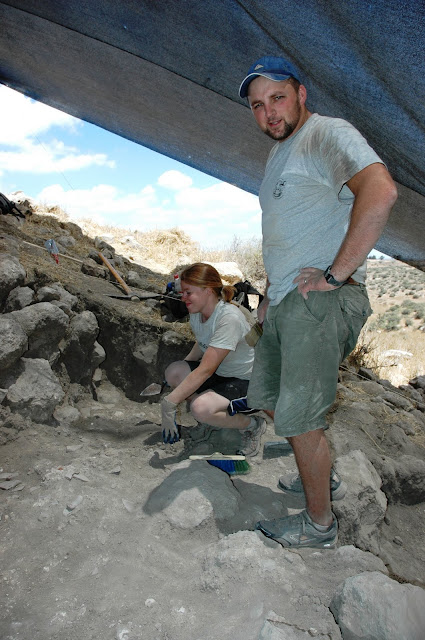You can check out the Tel Burna Excavation at the official website.
and Mindy's blog where she has been posting a lot of pictures of the excavation.
Mindy and I's square for the last week and a half - photos courtesy of Amit Dagam.
Working hard. This is probably a 9th century destruction level - although no one knows how far it will go across the site.
The site of Tel Burna is very interesting - it is in the Shephelah very close to Beth Guvrim/Maresha. It has never been excavated and the Israelite period is directly on the surface (a rarity nowadays). This is the first season of excavation and already the finds have been quite interesting including the discovery of Iron II fortification walls and a 9th century destruction level. Geographically, Burna may be identified with the biblical city of Libnah, which was a border town and Levitical city within Judah (Josh. 15:42; 21:13) on the fringe of southern Judah near Philistia. Two other prominent candidates for Libnah are Tel Goded and Tell Zayit. The excavations at Tel Burna are being carried out under the direction of Drs. Itzick Shai and Joe Uziel.
Here is a biblical concordance of Libnah. Note that in order for a site to be Libnah it need have material culture (remains) from each of these periods (unless of course that period was completely robbed out - which sometimes happens.)
- (ca. 1400 BC - Late Bronze I (according to an Early Conquest view - ca. 1200 BC Late Bronze II for a Late Conquest view) "As for Makkedah, Joshua captured it on that day and struck it, and its king, with the edge of the sword. He devoted to destruction every person in it; he left none remaining. And he did to the king of Makkedah just as he had done to the king of Jericho. Then Joshua and all Israel with him passed on from Makkedah to Libnah and fought against Libnah. And the LORD gave it also and its king into the hand of Israel. And he struck it with the edge of the sword, and every person in it; he left none remaining in it. And he did to its king as he had done to the king of Jericho. Then Joshua and all Israel with him passed on from Libnah to Lachish and laid siege to it and fought against it. And the LORD gave Lachish into the hand of Israel, and he captured it on the second day and struck it with the edge of the sword, and every person in it, as he had done to Libnah.” (Joshua 10:28–32 ESV)
- (Jehoram son of Jehoshaphat ca. 845 BC - Iron IIa) "So Edom revolted from the rule of Judah to this day. Then Libnah revolted at the same time.” (2 Kings 8:22 ESV; see also 2 Chron. 21:10)
- (During the time of Hezekiah ca. 701 BC Iron IIc) "Rabshakeh returned, and found the king of Assyria fighting against Libnah, for he heard that the king had left Lachish.” (2 Kings 19:8 ESV; see also Is. 37:8)
- (ca. 600 BC right before the destruction of Jerusalem - Iron IIc) "Jehoahaz was twenty-three years old when he began to reign, and he reigned three months in Jerusalem. His mother’s name was Hamutal the daughter of Jeremiah of Libnah.”(2 Kings 23:31 ESV)
- (ca. 586 BC right before the destruction of Jerusalem - Iron IIc) "Zedekiah was twenty-one years old when he became king, and he reigned eleven years in Jerusalem. His mother’s name was Hamutal the daughter of Jeremiah of Libnah.” (2 Kings 24:18 ESV; see also Jer. 52:1)





No comments:
Post a Comment